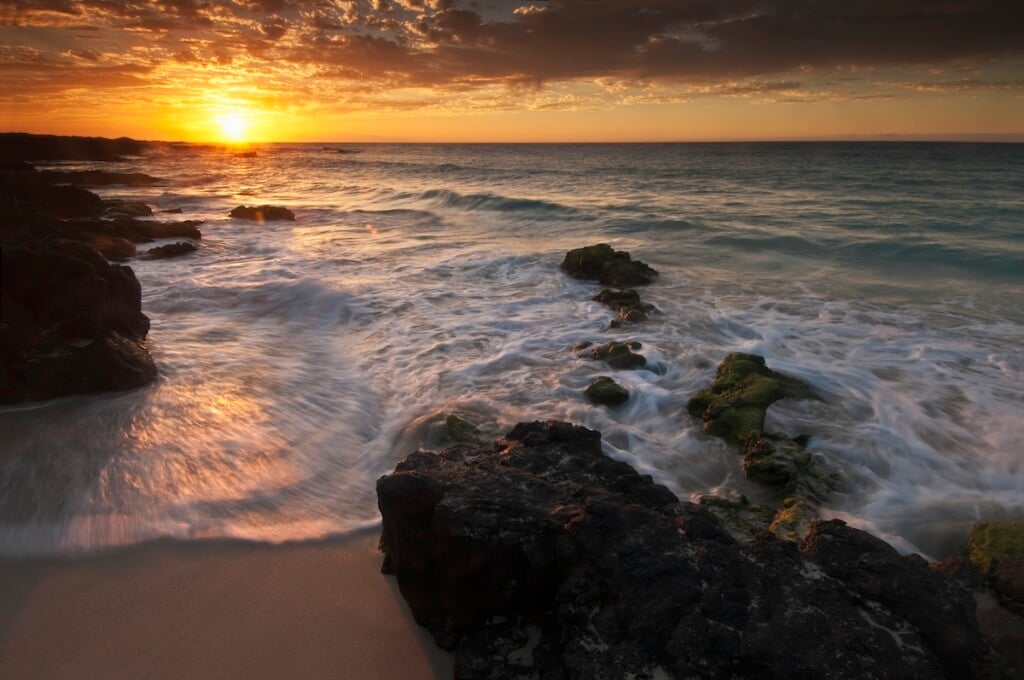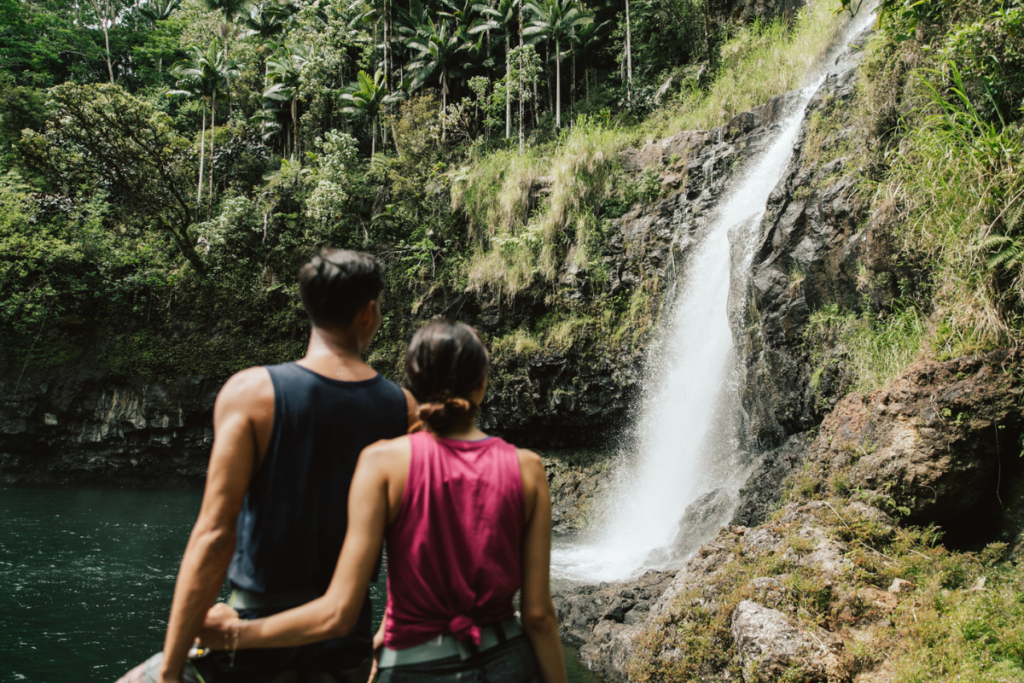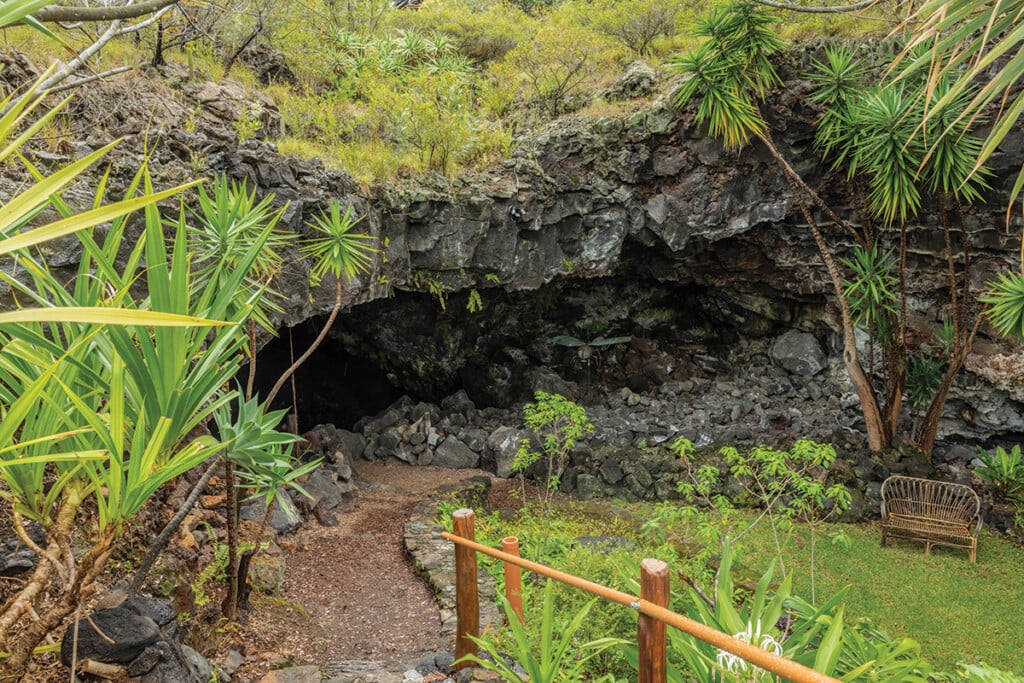10 Best Free Things To Do on Hawaiʻi Island
You don’t have to spend a cent to enjoy your vacation on the Big Island.

Getting to Hawaiʻi is expensive—then traveling to Hawaiʻi Island just adds to that. And that’s just the airfare. There are hotel and car rental costs—especially if you’re on the Big Island, where there’s no public transportation. So here are some free things you can do to cut costs and still enjoy your Hawaiʻi vacation.
1. Visit a Unique Beach

Papakōlea Beach on Hawaiʻi Island.
Photo: Getty Images/Damien VERRIER
Most beaches in Hawaiʻi—including Hawaiʻi Island—are free to visit. While the Big Island isn’t known for its long stretches of golden-sand beaches, it does boasts its own unique beaches you won’t find anywhere else. Papakōlea Beach on the island’s south end is one of only four green sand beaches in the world—and the only one in the U.S. (The green sand is actually olivine.) It’s challenging to get to: First you need to make the two-hour drive from Kailua-Kona to the parking area, then hike another 2.5 miles to the beach. But the experience will be well worth the effort.
The volcanoes on Hawaiʻi Island are still active, and you’ll find the most gorgeous black-sand beaches here. Located on the southeastern Kaʻū coast, Punaluʻu Black Sand Beach is one of the most famous black-sand beaches in the Islands. The beach itself is lined with coconut palms and you’ll often spot honu (Hawaiian green sea turtles) basking here. Keep your distance from the turtles, and swim at your own risk.
Another must-see beach is Pohoiki (aka aka Isaac Hale Beach Park), the newest beach to form on the Big Island, a result of the 2018 Kīlauea eruption. Swimming isn’t advised here, but the views are stunning.
For a more traditional beach-going experience, head to Kahaluʻu Beach Park in Kailua-Kona. This area is great for snorkeling and surfing.
2. Play with Goats
On the way to ʻAkaka Falls State Park—which requires an entrance fee for visitors, FYI—is Honomū Goat Dairy, a family-run goat dairy where you can buy farmstead cheeses, goat-milk soaps and the best caramel on the island. But, if you just want to play with baby goats, you can do that for free. Just look for the sign that says, “Free Goat Therapy.”
Read More: We Played With Baby Goats at This Hawaiʻi Island Dairy
3. Walk Around a Japanese Garden

Queen Liliʻuokalani Park and Gardens in Hilo.
Photo: Aaron K. Yoshino
Named after Hawaiʻi‘s last reigning monarch, the Liliʻuokalani Gardens in Hilo is the largest authentic ornamental Japanese garden outside of Japan. Yes, it’s true! Walk through this gorgeous 24.67-acre garden—dedicated in 1917 as a tribute to Hawaiʻi’s first Japanese immigrants—with bridges over fishponds, pagodas, rock gardens, Japanese stone laterns and a teahouse. There are great views of Hilo Bay. The park is open 24 hours and is—you guessed it—free.
4. Take a Hike

It takes more than 2 hours to drive from Hilo to Pololū Valley on Hawaiʻi Island.
Photo: Getty Images
Some of the best hiking trails on Hawaiʻi Island are in Hawaiʻi Volcanoes National Park. And unless you have an annual pass, you’ll have to pay an entrance fee. But there are a few hikes and walks around the Big Island that are free and open to the public. At the end of Highway 270 on the island’s northern tip is the Pololū Valley Overlook. There’s a fairly easy, 25-minute hike down to the valley floor and the black-sand beach at the bottom. (Swimming is not advised.) There’s also a great trail in the 100-acre Kalōpā State Park near Honokaʻa—about 15 miles east of Waimea and 40 miles north of Hilo. This area gets a lot of rain, so expect a lush and inviting native ʻōhiʻa forest. The family-friendly nature trail is ideal for keiki and visitors short on time. But you can extend your walk longer into the forest, too. It’s one of the few state parks that don’t require an entrance fee for visitors. Or hike through Kekaha Kai State Park on the Kona Coast. There’s a 4.5-mile hike north through the park on the historic coastal trail, Ala Kahakai, which leads to Kua Bay. You can also climb a 342-foot-tall cinder cone, which offers excellent views of the coastline.
5. Drive to the Southernmost Point in the U.S.

South Point on Hawaiʻi Island.
Photo: Getty Images/Julie Thurston
Hawaiʻi Island is home to the southernmost point in the U.S. Called Ka Lae—aka South Point—this area is believed to be where the first Polynesians arrived in the Hawaiian Islands somewhere between 400 and 800 A.D. A National Historic Landmark, this site features ruins of a heiau (Hawaiian temple), fishing shrines and other cultural vestiges. It’s also a popular spot for fishing; the waters off the point are very deep and abundant with large fish such as ʻahi, mahimahi and marlin. It’s a long haul to get here; it’s about a two-hour drive from Kona. Three miles from Ka Lae is Papākolea Beach, famous for its green sand made from olivine from the surrounding cinder cone. And in nearby Nāʻālehu, dine at the popular Punaluʻu Bake Shop, known for its Hawaiian sweet bread.
6. Go Stargazing

The Milky Way over Mauna Kea on Hawaiʻi Island.
Photo: Getty Images/Lorraine Boogich
The Big Island has some of the clearest skies around, and if you’re at 9,200 feet above sea level—meaning above the clouds—the view is even better. That’s the location of the Onizuka Center for International Astronomy Visitor Information Station, located on Maunakea Access Road near the summit of the world’s largest mountain. The center is open from 9 a.m. to 9 p.m. daily, and you can visit the VIS First Light Store and marvel at the star-filled sky above. (Due to hazards of altitude sickness, pregnant women, anyone in poor health and children under 13 shouldn’t venture above this visitor information station.)
7. Sample Kona Coffee
View this post on Instagram
There are millions of coffee trees growing in Hawaiʻi, the only state that grows the crop commercially and in huge quantities. According to the U.S. Department of Agriculture, Hawaiʻi boasts 6,500 acres of land in coffee production, producing 24 million pounds of coffee in a season. While coffee production has expanded to islands other than Hawaiʻi Island, 95% of all coffee products in the state still come from the Big Island. Most coffee farms are open to the public, and some offer free tours and tastings. The family-run Greenwell Farms in Kona is one of the largest and oldest coffee producers on the island, with coffee orchards sprawling across 85 acres. While it offers a deluxe farm tour and a manual brewing class—both require fees—Greenwell Farms has a popular free 45-minute guided tour that gives guests an inside look at the history, farming and processing of coffee before sampling the farm’s 100% Kona coffee. Tours run from 9 a.m. to 3 p.m. daily. Nearby, Mountain Thunder Coffee offers a free 20-minute guided tour daily—which is also wheelchair- and stroller-friendly—that ends of a sampling of the farm’s 100% Kona coffees.
Read More: A Brief History of Kona Coffee, Hawaiʻi’s Most Caffeinated Crop
8. Gawk at a Waterfall

Rainbow Falls.
Photo: Aaron K. Yoshino
You’ll have to pay a small fee to see ʻAkaka Falls, but you can view Waiānuenue (aka Rainbow Falls) in Hilo for free. The 80-foot falls is known for its vibrant rainbows that can be seen in the mist around mid- to late-morning on sunny days. (Hence its nickname.) The waterfall is part of the 28-mile Wailuku River, the longest in the state.
9. Take a Cultural Class

Master lei maker Kilohana Domingo making a braided lei of lehua flowers at Kalaelilohana Bed and Breakfast, Kaʻū.
Photo: Getty Images/Lonely Planet
Learning about Hawaiʻi’s rich and unique culture is what makes a vacation in the Islands so special. The Queens’ Marketplace in Waikoloa offers free ʻukulele lessons (first come first serve basis) and a lei-making workshop once a month. Many hotels offer cultural classes and experiences that are free to guests. The Hilton Waikoloa Village, for example, offers lei-making, kukui bracelet-making and ʻukulele classes. The Four Seasons Resort Hualālai’s Kaʻupulehu Cultural Center hosts various complimentary cultural classes, from lei-making to Hawaiian language. And the Fairmont Orchid, Hawaiʻi has a variety of enriching classes, including hula lessons, an art walk and a tour of the hotel’s Chef’s Garden. Check with your hotel concierge for information.
10. Volunteer

A volunteer replants a koa tree on Hawaiʻi Island.
Photo: Courtesy of the Hawaiʻi Tourism Authority/Heather Goodman
One of the best, most impactful things you can do on vacation—on Hawaiʻi Island or anywhere—is volunteer. And there are lots of ways to give back. Every Saturday from 9:30 a.m. to 12:30 p.m., you can volunteer to do garden work at the Amy Greenwell Ethnobotanical Garden, a 15-acre biocultural kīpuka in South Kona with over 200 species of native and Polynesian-introduced plants. (It’s great for all ages.) ʻŌhiʻa Ridge Farm on the slopes of Mauna Kea takes volunteers on weekends from August through May and weekdays during the summer to help with potting seedlings, planting trees and shrubs, weeding and watering. Lunch, water, gloves and equipment are provided. Dog lovers can take a shelter dog to the beach or on a hike with the Hawaiʻi Island Humane Society’s Field Trips for Shelter Dogs program. (The nonprofit does ask for a $25 donation.)



